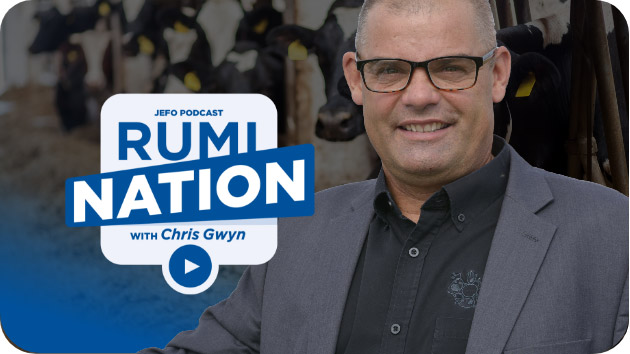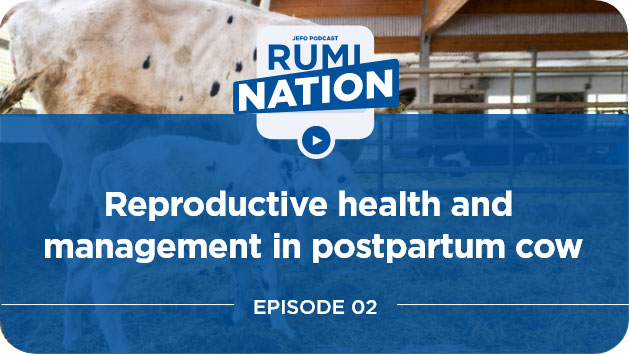RumiNation | S04 : E01
Factors Impacting Feed Efficiency in the Feedlot in Cattle
Brought to you by Jefo Nutrition
Share now!
Did you enjoy this episode?
Share now!
Our guest - Dr. Katie Wood
Dr. Katie Wood developed a passion for animal agriculture early in life through her experiences on her family’s cow/calf operation and through her involvement in the 4-H program. After concluding her Ph.D., she completed an NSERC post-doctoral fellowship at the University of Saskatchewan. During this time her work focused on understanding gut barrier function and nutrient absorption in ruminants and their interactions with health, metabolic disease and production efficiencies. Katie returned to the University of Guelph in April 2016 as a faculty member. Outside of her research, Katie breeds, owns and shows Simmental cattle and Polled Dorset sheep.

Contact
Join the Rumination community
Timestamps & Summary
1:47
You recently participated in JEFO’s annual JEFO beef Academy and presented key management and nutritional approaches to improving feed efficiency in feedlot cattle. Could you summarize what you presented during that symposium?
Dr. Katie Wood
A lot of my research focuses on feed efficiency and understanding feed efficiency. But in the feedlot, the aspect of gut health influences feed efficiency as well. So, if we have challenges with gut health related to rumen acidosis, and liver abscesses, certainly that is going to impact how those animals are performing and ultimately, feed to gaining in cost production for producers. My research in the feedlot looks at how we can improve gut health and improve production efficiency through those aspects.
8:04
I know you mentioned some other points related to feed efficiency, but I did not want to leave fecal starch in uNDF too quickly, because I am pretty sure you’ve done some work with some NIRS with fecal starch and that seems practical and exciting. I am wondering if you could expand on that.
Dr. Katie Wood
Some colleagues at University of Saskatchewan are looking at fecal measurements using NIRS. We are familiar in the feed industry with using NIRS as a measure for nutrients, but the same can be applied to the feces as well, we just need to build some of those standardization curves. There was a paper put out with University of Lethbridge and University of Saskatchewan, where they were looking at using the NIR to measure fecal starch and it can be done easily. Some of these larger feedlots potentially that may have an NIR on farm could simply measure fecal starch right there rather than sending it out.
9:56
So today you would really be encouraging field gut nutritionists to make sure that they are getting a 240-hour analysis done routinely?
Dr. Katie Wood
It is certainly something that we are finding, being able to more accurately predict what the growth curve will be and how those animals will perform. So, I would encourage a nutritionist to consider adding that as another analysis.
11:23
What are the other things that you would make sure are being looked after or considered to improve feed efficiency?
Dr. Katie Wood
The other important thing is reducing stress and improving consistency. And they go hand in hand. We know that variable intake and variation can cause rumen distress and inflammation and stress to the animal. And certainly, as we introduce more stress, that impacts nutrient partitioning, and therefore growth.
16:03
What do you want to focus on, either in your research or in the industry on improving feed efficiency and cattle?
Dr. Katie Wood
One thing I will mention is we are starting to realize that, particularly related to gut health and liver abscesses, is the longer we keep cattle on feed, and that trend towards increasing carcass weights, we know that’s the end period, where we even start to see a little bit of decrease in performance of those animals. It is also a time period where we see increased risk of acidosis as opposed to earlier in the feeding period. And we know these cattle are heavy, we know that they are highly stressed, sometimes because of that weight. Sometimes we have some challenges with some feet issues. And we think that there could be some implications, again, related to insulin insensitivity and Energy Commission as well.
20:12
Is there any other points you’d like to stress when it comes to managing and improving feed efficiency and cattle?
Dr. Katie Wood
Certainly. Talking about that receiving period, which is kind of one of the higher risk time periods, you have cattle coming from all different sources, they may have been shipped across the country. So, do not forget about treating those receiving cattle well, because we know that it pays off in the long term. We do not have a good handle on how much that impacts the feed conversion over the rest of the feeding period. But certainly, we know, related to illness, it has a huge effect.
Need more information?








